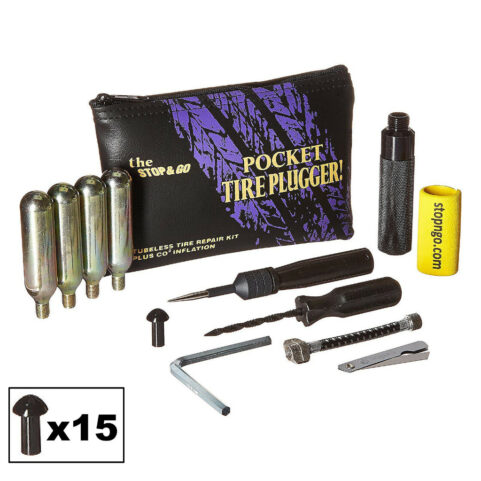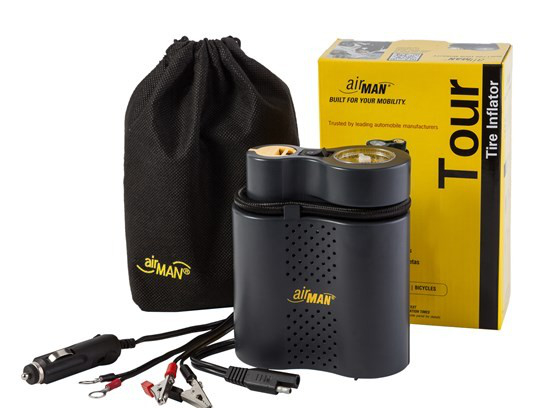By Andy Lawson
Back last summer, on my way home after a wonderful weekend staying in Ludlow and riding around mid-Wales, I managed to pick up what looked like a metal clip or staple of some sort in my rear tyre. Luckily for me, the tyre didn’t deflate enough to cause me any issues during the ride home. Indeed, I didn’t get a warning through the sensor, that the pressure may have been dropping. It wasn’t until two days later, when I went into the garage, that I noticed my rear tyre had deflated. Not fully, but obviously enough to see that I had a problem.
After looking closely, I could see the metal object, right in the middle of the main tread. At this point, considering the tyre was new last year and I had done less than 1000 miles on it, mainly because of the Covid restrictions, I said “Gosh, that’s a little unfortunate”. Well words to that effect, as they may have been a tad more colourful.
Now, in just two days’ time, my bike was booked in at North Oxford Garage for a service. I therefore thought that I either needed to try and pump some air in to see how long it would stay up and perhaps risk the 20-mile ride to Oxford and get them to repair or try and repair it myself. After some thought, especially of the possibility of the tyre deflating too much on my ride and being stranded on the side of the road, I decided it would be best to try and repair it. After all, I had a puncture repair kit although had never used it. Perhaps this was a good time to try and get some experience, rather than the first time being stuck on the side of a road or having to wait for recovery services.
The puncture repair kit I have, is called The Stop & Go. This particular kit has rubber grommet type plugs, which are inserted into the puncture hole. Picture of the kit as shown below.

I managed to do an effective repair and reinflate the tyre. I have a compressor in my garage, so pumping up was quite easy for me. I didn’t have to use the small air cylinders provided. To be honest, I feel those should be used only when there is absolutely no alternative. I’m not overly convinced there would be enough to inflate fully, but perhaps enough to get to a garage. Indeed, I also carry a small electric pump with me on the bike, which I can attach to the vehicle battery.

While looking through the instructions for the repair kit, I noticed a warning saying, that if the tyre to be repaired is wire braced, while the puncture repair will work, the tyre should be replaced at the earliest opportunity. Part of the repair process includes reaming out the hole to fit the plug, this obviously breaks through the wire brace weave. By breaking the weave, although this is moulded into the rubber, there is a risk that the weave could now separate, due to the tyre air pressure. The repair should therefore be seen as a short-term repair and the tyre replaced as soon as possible. Once again, I said something like “Oh dash it!” Yes, well, something like that <cough>.
The tyre was repaired. It stayed inflated and didn’t lose any pressure over the next two days or on my ride to North Oxford Garage for the bike service. I did however, phone them a couple of days before hand to order in a new tyre and to be fitted while I was there.
After the bike service and new tyre fitted, I asked Sebastian on the service desk, if he would be so kind as to take a few photos of the old tyre and the repair and send them to me. I was interested to know just how well the plug sealed and as shown from inside the tyre.
Below are a few photos, which really show how well the plug seals the hole in a mushroom like shape.
As you can see from the photos, there was A LOT of tread left on the tyre. An unfortunate and expensive experience having to replace so soon. I’m sure there are some who would’ve perhaps not replaced and continued with the repaired tyre. Indeed, I’ve spoken to one or two who have ridden over 1000 miles after such a repair. Whether that was on a wire braced tyre, I don’t know. However, there is a risk identified for when repairing a wire braced tyre. How much of a risk? Well, a blow out when in a car is bad enough, but on a bike? I would also expect there could well be some challenges with any motorbike insurance claim if there was an accident caused due to the tyre letting go, possibly even open to prosecution
To use a quote from an old TV program Hill Street Blues: “Let’s be careful out there!”









You must be logged in to post a comment.